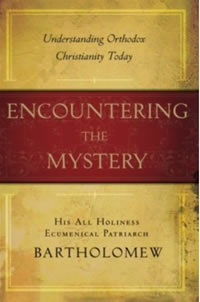Book Notes
 Bartholomew I, His All Holiness Ecumenical Patriarch, Encountering the Mystery; Understanding Orthodox Christianity Today (New York: Doubleday, 2008), 252pp.
Bartholomew I, His All Holiness Ecumenical Patriarch, Encountering the Mystery; Understanding Orthodox Christianity Today (New York: Doubleday, 2008), 252pp.
For many Christians in the west, both Protestant and Catholic, Eastern Orthodox Christianity remains largely unknown, overlooked and even ignored. Orthodox believers constitute a family of fifteen self-governing and “autocephalous” churches that are united in liturgy and doctrine but administratively independent. By some estimates they number 300 million adherents. Whereas Rome fell in the late fifth century, Byzantine Christianity flourished for a millennium, from the time when Constantine established “New Rome” in what is today Istanbul until its fall to the Ottoman Empire in 1453. In the United States, since the late 1980s, a steady trickle of mainly Protestant evangelicals have converted to Orthodox.
It’s hard to imagine a better guide to the Orthodox than Bartholomew I (b. 1940). In 1991 he was elected as the Archbishop of Constantinople and the Ecumenical Patriarch who serves as the spiritual leader over the entire Orthodox communion. In Orthodox parlance he has no juridical authority but he enjoys a primacy of honor as the “first among equals.” His personal background and sustained efforts over the last twenty years have earned him a reputation as an outspoken advocate of reconciliation among world religions, ecumenicity among Christians, and care for the environment. He’s a Turkish citizen of Greek heritage, situated at the geographic, cultural, political and religious crossroads of Islam, Judaism and Christianity, and he’s fluent in eight languages.
Bartholomew begins with a general introduction to Orthodox history, theology, and worship. He explains the aesthetic elements of Orthodoxy as seen in its architecture, icons and liturgy. He describes the influential role of monastic spirituality and the sacraments. I’ve always appreciated the Orthodox emphasis on “apophatic” theology, the notion that the transcendent God is beyond human definition and comprehension, yet truly immanent: “God as unknowable and yet as profoundly known; God as invisible and yet as personally accessible; God as distant and yet as intensely present. The infinite God thus becomes truly intimate in relating to the world” (186). In the last half of the book Bartholomew turns to matters of ecology, human rights, social justice, war and peace, and dialogue. Throughout his book he shares personal anecdotes about his childhood, seminary days, visiting the famous monastery at Athos, and his numerous ecumenical and environmental undertakings. This is a good book by a great man, but for an introduction to Orthodoxy there’s still none better than The Orthodox Church by Bishop Kallistos (Timothy) Ware of Oxford, first published in 1963 and now available in any number of revised editions.


